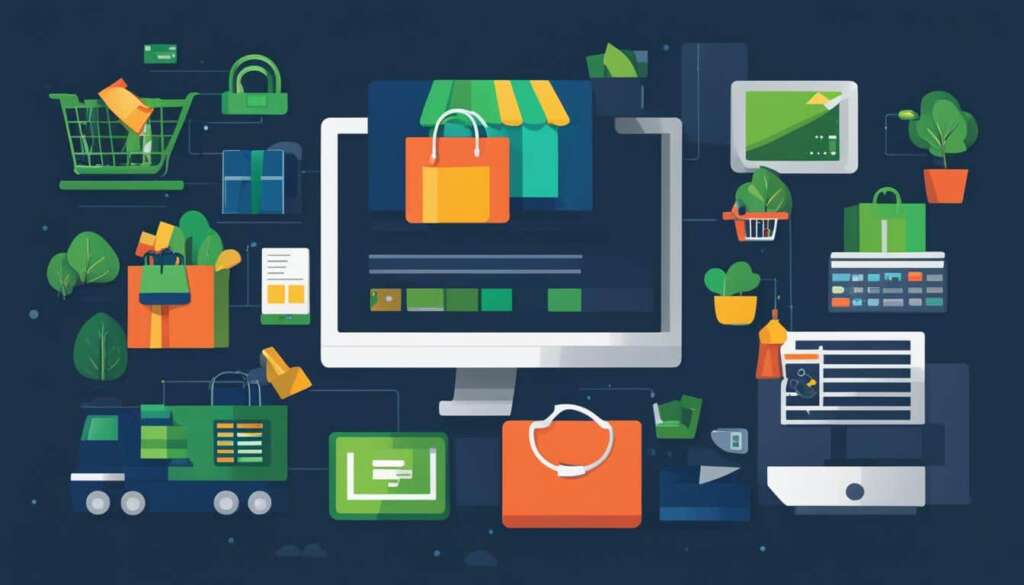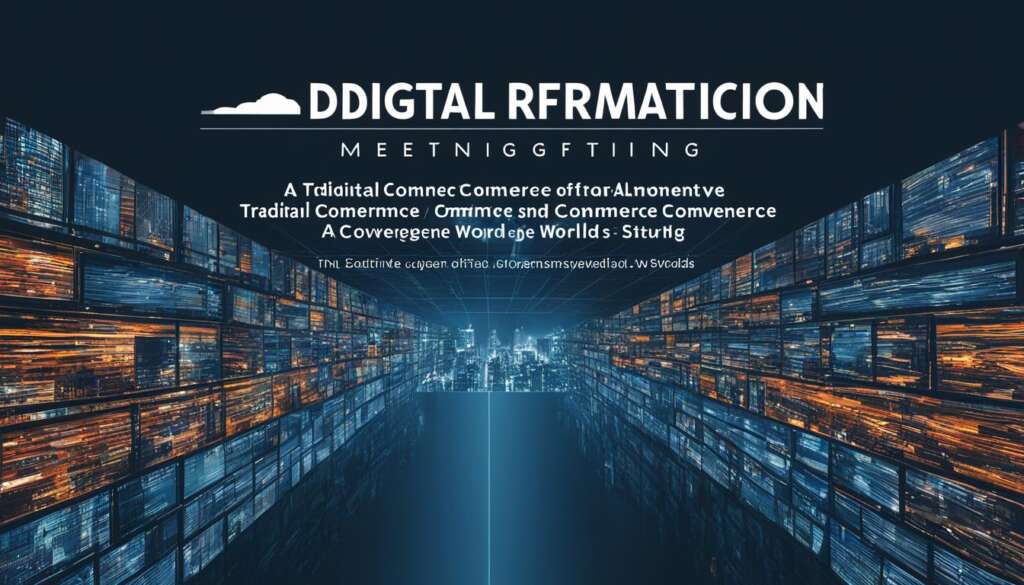Table of Contents
Welcome to our article on B2B e-commerce, where we will explore the best practices and provide examples of successful online business interactions. In today’s digital age, B2B e-commerce has become a crucial tool for companies looking to enhance their sales efficiency and expand their market reach.
According to industry reports, B2B e-commerce is experiencing rapid growth, with sales expected to reach nearly $1.77 trillion in 2022 alone. This represents a 12% increase from the previous year, highlighting the immense potential of the B2B e-commerce sector. In addition, B2B e-commerce volume is projected to reach 12.2 trillion globally, with the United States accounting for 6.7 trillion of that volume.
Throughout this article, we will delve into the world of B2B e-commerce, discussing its advantages and disadvantages, how it works, and the different types of businesses involved. We will also highlight some best practices that can help businesses thrive in the B2B e-commerce space.
To provide a comprehensive look at B2B e-commerce, we will include relevant examples and real-world case studies. Additionally, we will touch on the importance of user experience, personalization, and staying up to date with industry trends in order to achieve sustainable growth and online success.
Understanding B2B E-Commerce
B2B e-commerce is a rapidly growing industry that revolutionizes business-to-business transactions. In this digital era, businesses engage in online sales through dedicated platforms and online stores, catering specifically to other businesses rather than consumers.
While B2B e-commerce shares similarities with its B2C counterpart, such as utilizing online sales platforms, it has distinctive considerations and challenges. Unlike B2C e-commerce, which focuses on selling products or services directly to consumers, B2B transactions occur between business entities, including manufacturers, wholesalers, and distributors.
“B2B e-commerce allows businesses to streamline their operations and drive sales efficiency by leveraging online platforms and store setups.”
This distinct separation between business entities requires customized approaches in terms of marketing, sales, and customer engagement. Understanding these nuances is essential for businesses embarking on the B2B e-commerce journey.
Key Aspects of B2B E-Commerce
Here are some key aspects that differentiate B2B e-commerce from traditional B2C online sales:
- Business-to-Business Focus: B2B e-commerce centers around enabling efficient transactions between businesses, enhancing supply chain management, and improving business collaborations.
- Online Store and Platforms: B2B e-commerce relies on dedicated online stores and platforms that cater to the specific needs of businesses, providing features such as bulk ordering, customized pricing, and streamlined procurement processes.
- Complexity and Customization: B2B transactions often involve intricate negotiations, custom product configurations, and personalized pricing to meet the unique requirements of business buyers.
- Longer Sales Cycle: Due to the complexity of B2B purchases and the involvement of multiple stakeholders, the sales cycle in B2B e-commerce tends to be longer compared to B2C.
Understanding the B2B E-Commerce Landscape
Visualizing and comprehending the B2B e-commerce landscape is crucial for businesses looking to thrive in this digital domain. The following table presents an overview of key components and interactions within the B2B e-commerce ecosystem:
| Business Entities | Key Interactions |
|---|---|
| Manufacturers | Production and supply of products |
| Wholesalers | Bulk distribution of products to retailers and businesses |
| Distributors | End-to-end supply chain management, storage, fulfillment, and shipping services |
Understanding the roles and dynamics between these entities helps businesses navigate the B2B e-commerce ecosystem effectively.
To gain a better understanding of B2B e-commerce, let’s explore the advantages it offers in the next section.
Advantages of B2B E-Commerce Businesses
B2B e-commerce businesses offer several advantages, including improved operational efficiency for both buyers and owners, expanded market reach, and the ability to provide flexible single-platform product and service offerings.
By streamlining processes and centralizing communication, B2B e-commerce can simplify business management and enhance productivity. This operational efficiency allows businesses to save time and resources, leading to cost savings and increased profitability. It also enables seamless collaboration between different departments and stakeholders, facilitating smoother transactions and reducing errors.
B2B e-commerce enables businesses to expand their market reach beyond traditional boundaries. By establishing an online presence, companies can access a global customer base and tap into new markets. This extended market reach opens up opportunities for growth, allowing businesses to reach untapped customers and increase sales revenue.
Additionally, the flexibility of offering products and services on a single platform is a major advantage of B2B e-commerce. It allows businesses to cater to the diverse needs of their customers and provide tailored solutions. With a single-platform offering, customers can easily find and purchase products or services, simplifying the buying process and enhancing customer satisfaction.
Furthermore, B2B e-commerce platforms offer advanced features for personalized experiences. By leveraging customer data and analytics, businesses can provide targeted recommendations and customized offers, enhancing customer loyalty and driving repeat sales.
“B2B e-commerce businesses can benefit from operational efficiency, expanded market reach, and single-platform offerings, enabling streamlined processes, global access, and tailored solutions for customers.”
Disadvantages of B2B E-Commerce Businesses
While B2B e-commerce offers numerous benefits, there are also some disadvantages to consider. The buyer’s journey in B2B e-commerce can be complex, requiring customized solutions and approvals at different stages. This complexity can lengthen the sales process and make it more challenging to convert leads into customers. Additionally, there is no one-size-fits-all e-commerce platform for B2B businesses, as each customer may have unique requirements that necessitate customization. Choosing a flexible platform that can accommodate these individualized needs is crucial for success in the B2B e-commerce space.

“The buyer’s journey in B2B e-commerce can be similar to solving a complex puzzle. Each step requires careful consideration and customization to successfully navigate through the intricate stages.”
Customized Solutions and Approvals
Unlike the relatively straightforward B2C buying process, the B2B buyer’s journey involves multiple stakeholders, each with their own unique requirements and approval processes. B2B customers often have specific needs that demand customized solutions and supplier vetting. This requires extensive communication and collaboration between buyers and sellers, adding complexity and time to the sales process. A thorough understanding of the customer’s business, challenges, and specific requirements is essential to provide tailor-made solutions.
Lengthened Sales Process
The multi-step nature of B2B e-commerce can extend the sales process, making it more challenging to convert leads into customers. From initial research and problem identification to product evaluation, negotiations, and final approvals, each stage of the buyer’s journey requires time and effort. B2B sellers must be prepared to invest resources into nurturing leads and providing exceptional customer service throughout the lengthy process.
Customization Challenges
One of the downsides of B2B e-commerce is the lack of a one-size-fits-all solution. Each B2B customer may have unique requirements that necessitate customization, whether it’s integrating with existing systems, implementing complex pricing structures, or adapting the user interface and experience. This customization can pose challenges for businesses navigating the B2B e-commerce space, as finding a platform that can accommodate their specific needs becomes crucial.
Despite these challenges, B2B e-commerce remains a lucrative avenue for business growth. By understanding the complexities of the buyer’s journey and addressing the unique requirements of B2B customers, businesses can overcome these disadvantages and unlock the immense potential of B2B e-commerce.
How B2B E-Commerce Works
B2B e-commerce relies on the use of online sales portals to facilitate transactions between businesses. These portals enable manufacturers, wholesalers, and distributors to sell their products or services to other businesses. The B2B buying or purchasing process typically involves several steps, including problem acknowledgment, product/service specifications, customer supplier and product search, product/service selection, approvals, and purchasing and e-procurement. Each step in this process requires careful consideration and customization to meet the specific needs of B2B customers.
The Purchasing Process in B2B E-Commerce
- Problem Acknowledgment: Businesses identify the need for a product or service.
- Product/Service Specifications: Detailed specifications are defined to meet the requirements of the business.
- Customer Supplier and Product Search: Businesses search for potential suppliers and products that meet their needs.
- Product/Service Selection: Businesses evaluate different options and select the most suitable product or service.
- Approvals: The selected product or service undergoes internal approvals within the business.
- Purchasing and E-Procurement: The final purchase is made through the online sales portal, completing the B2B e-commerce transaction.
Throughout the purchasing process, businesses engage with the online sales portal to browse products or services, compare prices and features, communicate with suppliers, place orders, and manage transactions. These portals provide a centralized platform for businesses to streamline their procurement processes and make efficient purchasing decisions.
“B2B e-commerce has revolutionized the way businesses conduct transactions, making the purchasing process more accessible and efficient. With online sales portals, businesses can easily connect with suppliers, explore a wide range of products, and make informed purchasing decisions.”
Integrating e-procurement systems with online sales portals further enhances the efficiency of B2B e-commerce, allowing businesses to automate and simplify their procurement processes. By integrating their internal systems with the online sales portal, businesses can synchronize inventory, track orders, and manage payments seamlessly.
Overall, the B2B e-commerce purchasing process is a complex and multifaceted journey that requires careful consideration and customization. Online sales portals play a crucial role in facilitating these transactions, enabling businesses to connect, communicate, and transact with suppliers efficiently.
| Benefits | Challenges |
|---|---|
| – Improved operational efficiency for buyers and sellers | – Complex buyer’s journey and multi-step sales process |
| – Expanded market reach and increased sales opportunities | – Customization requirements for individualized platforms |
| – Flexible single-platform product and service offerings |
Types of B2B E-Commerce Businesses
B2B e-commerce encompasses various types of businesses that engage in online transactions. Manufacturers, wholesalers, and distributors play vital roles in this industry, each with its own unique characteristics and requirements.
1. Manufacturers
Manufacturers are the primary producers of goods in the B2B e-commerce ecosystem. They create and manufacture products, which they sell to wholesalers or other businesses. Manufacturers often have direct control over the production process, allowing them to maintain product quality and customization.
2. Wholesalers
Wholesalers act as intermediaries between manufacturers and retailers or smaller businesses. They purchase products in bulk from manufacturers and distribute them to their business clients. Wholesalers play a crucial role in ensuring a streamlined supply chain, offering competitive pricing, and providing logistical support.
3. Distributors
Distributors are key players in B2B e-commerce, handling the end-to-end management of the supply chain. They collaborate with manufacturers and wholesalers to store, fulfill, and ship products on behalf of their business clients. Distributors provide value-added services such as inventory management, order processing, and delivery logistics.
| Business Type | Role | Primary Function |
|---|---|---|
| Manufacturers | Producers | Create and sell products to wholesalers or businesses |
| Wholesalers | Intermediaries | Purchase products in bulk and distribute them to retailers or businesses |
| Distributors | Supply Chain Managers | Manage storage, fulfillment, and shipping on behalf of business clients |
B2B e-commerce relies on the collaboration between manufacturers, wholesalers, and distributors to facilitate seamless online transactions and meet the unique needs of businesses.

With a clear understanding of the different types of B2B e-commerce businesses, it becomes evident that each entity plays a crucial role in the overall ecosystem. By leveraging their specific expertise and collaborating effectively, manufacturers, wholesalers, and distributors contribute to the growth and success of B2B e-commerce.
B2B E-Commerce Best Practices
When it comes to B2B e-commerce, implementing best practices can make all the difference in achieving success. By focusing on enhancing the user experience, promoting personalization, and optimizing conversions, businesses can stay ahead in the competitive B2B market. Here are some key best practices to consider:
- Ensure an Error-Free Website: A website with smooth navigation and a user-friendly interface is crucial for a positive user experience. Regularly conduct thorough testing and maintenance to fix any errors or glitches.
- Optimize Product Listings: High-quality imagery and informative descriptions are essential for showcasing products effectively. Invest in professional photography and provide detailed specifications to help buyers make informed decisions.
- Create Intuitive Site Navigation and Search Functionality: A well-organized website structure and intuitive search functionality make it easier for customers to find what they need. Implement filters, categories, and relevant tags to enhance search results.
- Optimize for Mobile Devices: With increasing mobile usage, it’s vital to ensure your website is mobile-friendly. Optimize the design and functionality to provide a seamless experience across devices.
- Offer a Secure and Seamless Checkout Process: A smooth and secure checkout process creates trust and encourages conversions. Implement robust security measures and offer payment options that cater to different customer preferences.
- Provide Excellent Customer Service and Support: Promptly respond to customer inquiries, provide clear communication, and offer personalized assistance throughout the buying journey. Exceptional customer service builds loyalty and encourages repeat business.
- Utilize Analytics to Track and Optimize Performance: Regularly analyze website data and user behavior to identify areas for improvement. Track key metrics such as bounce rates, conversion rates, and user engagement to make data-driven decisions.
- Stay Updated with the Latest Industry Trends and Technologies: B2B e-commerce is constantly evolving, with new technologies and trends emerging. Stay informed and adapt to changing customer preferences and market dynamics to stay competitive.
Implementing these best practices can help B2B e-commerce businesses provide an exceptional user experience, drive personalization, and optimize conversions. By continuously improving and staying ahead of the curve, businesses can thrive in the dynamic world of B2B e-commerce.
Conclusion
B2B e-commerce offers tremendous potential for businesses to achieve significant growth and online success. By implementing best practices, businesses can optimize their user experience, increase conversions, and drive sustainable business growth in the highly competitive e-commerce landscape. It is crucial for businesses to stay up-to-date with the latest trends, technologies, and strategies in B2B e-commerce to remain competitive and capitalize on the immense opportunities this industry presents.
By leveraging the power of B2B e-commerce, businesses can expand their customer base, reach new markets, and enhance operational efficiency. Implementing best practices such as error-free websites, high-quality product listings, intuitive navigation, and mobile optimization can provide businesses with a competitive edge. Additionally, personalized customer experiences, secure checkout processes, and excellent customer service are crucial for nurturing long-term relationships with B2B clients and driving success.
As B2B e-commerce continues to grow, businesses must focus on continuous improvement and adaptation to meet the evolving needs of their customers. By staying informed and proactive, businesses can capitalize on the opportunities presented by B2B e-commerce and achieve sustainable growth, ensuring long-term success in the digital marketplace.
FAQ
What is B2B e-commerce?
B2B e-commerce refers to the sale of products or services between businesses through an online store or platform. It involves transactions between business entities, such as manufacturers, wholesalers, and distributors, rather than between businesses and consumers.
How does B2B e-commerce differ from B2C e-commerce?
B2B e-commerce can be distinguished from B2C e-commerce, which involves selling products or services directly to consumers. While there are similarities between the two, such as the use of online sales platforms, B2B e-commerce has its own unique considerations and challenges.
What are the advantages of B2B e-commerce businesses?
B2B e-commerce businesses offer several advantages, including improved operational efficiency for both buyers and owners, expanded market reach, and the ability to provide flexible single-platform product and service offerings.
Are there any disadvantages to B2B e-commerce?
While B2B e-commerce offers numerous benefits, there are also some disadvantages to consider. The buyer’s journey in B2B e-commerce can be complex, requiring customized solutions and approvals at different stages. Additionally, there is no one-size-fits-all e-commerce platform for B2B businesses, as each customer may have unique requirements that necessitate customization.
How does B2B e-commerce work?
B2B e-commerce relies on the use of online sales portals to facilitate transactions between businesses. These portals enable manufacturers, wholesalers, and distributors to sell their products or services to other businesses. The B2B buying or purchasing process typically involves several steps, including problem acknowledgment, product/service specifications, customer supplier and product search, product/service selection, approvals, and purchasing and e-procurement.
What are the different types of B2B e-commerce businesses?
B2B e-commerce encompasses various types of businesses that engage in online transactions. Manufacturers sell their products to wholesalers or other businesses, while wholesalers distribute products in bulk to retailers or smaller businesses. Distributors play a crucial role in managing the end-to-end supply chain and providing services such as storage, fulfillment, and shipping on behalf of their business clients.
What are some best practices for B2B e-commerce?
To succeed in B2B e-commerce, businesses should implement best practices that enhance the user experience, promote personalization, and optimize conversions. Some of these best practices include ensuring an error-free website, optimizing product listings, creating an intuitive site navigation, offering a secure checkout process, providing excellent customer service and support, utilizing analytics, and staying updated with industry trends and technologies.
What are the benefits of B2B e-commerce for business growth?
B2B e-commerce presents significant opportunities for businesses to expand their customer base and enhance their online sales efficiency. By implementing best practices, businesses can improve their user experience, increase conversions, and achieve sustainable growth in the competitive e-commerce landscape.













